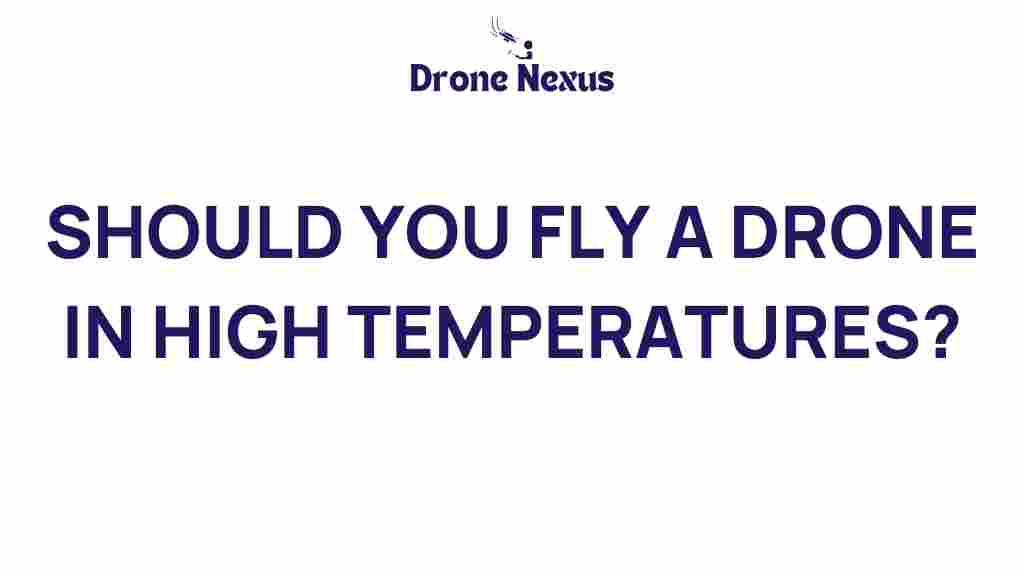Drone Safety: Can You Fly a Drone in High Temperatures?
As drone technology continues to evolve, enthusiasts and professionals alike are eager to utilize these flying machines for various applications. However, one question that often arises is, can you fly a drone in high temperatures? This article will explore drone safety practices in hot weather, the potential impacts of heat on drone performance, and essential tips for operating drones safely in elevated temperatures.
Understanding the Effects of High Temperatures on Drones
Before diving into drone safety practices, it’s crucial to understand how high temperatures can affect your drone. Here are some key points:
- Battery Performance: Most drones operate on lithium-polymer (LiPo) batteries, which can be sensitive to temperature changes. High temperatures can lead to decreased battery life or even damage.
- Motor Functionality: Excessive heat may cause the drone’s motors to overheat, resulting in performance issues or failure.
- Electronic Components: Drones contain various electronic components that can be adversely affected by heat, potentially leading to malfunctions.
- Flight Stability: High temperatures can affect air density, influencing the drone’s lift and stability.
Given these factors, it’s vital to prioritize drone safety when flying in hot conditions. Below are steps you can take to ensure a safe flight experience.
Step-by-Step Guide to Flying a Drone in High Temperatures
1. Pre-Flight Checks
Performing thorough pre-flight checks is essential for ensuring drone safety. Here’s what you should do:
- Inspect the Battery: Check the battery for any signs of swelling or damage. If the battery appears compromised, do not use it.
- Monitor Temperature: Before flying, monitor the ambient temperature. If it exceeds the manufacturer’s recommended limits, consider postponing your flight.
- Check the Drone’s Firmware: Ensure that your drone’s firmware is up to date, as manufacturers often release updates to improve performance in various conditions.
2. Choose the Right Time of Day
Temperatures tend to be cooler during early mornings and late afternoons. Consider scheduling your flights during these times to minimize heat exposure.
3. Stay Hydrated
While this may not directly impact your drone, it’s essential for maintaining your focus and decision-making abilities. Ensure you drink plenty of water before and during your flight.
4. Monitor Battery Temperature
Keep an eye on the battery temperature during your flight. If it gets too hot, it may be wise to land the drone immediately to prevent damage. Most drones come with built-in temperature monitoring systems that alert you when the battery is overheating.
Troubleshooting High-Temperature Issues
Even with proper precautions, issues can arise during flights in high temperatures. Here are some common problems and their solutions:
1. Drone Overheating
If your drone becomes unresponsive or starts to overheat, follow these steps:
- Land Immediately: If you notice signs of overheating, land your drone as soon as it is safe to do so.
- Allow Cool Down: Give your drone time to cool down after landing. Avoid touching the motors or battery directly, as they may be extremely hot.
- Inspect for Damage: Once cooled, inspect your drone for any signs of damage or wear.
2. Reduced Flight Time
High temperatures can decrease battery performance, leading to shorter flight times. If you notice a drop in flight time, consider these tips:
- Limit Flight Duration: Plan for shorter flights to avoid battery drain.
- Fly in Short Bursts: If possible, fly in short bursts to allow the battery to recover between flights.
Additional Tips for Drone Safety in High Temperatures
To further ensure drone safety while flying in hot weather, consider the following tips:
- Use a Cooling System: Some drone enthusiasts have found success using external cooling systems or heat sinks to keep their drones cool during flights.
- Avoid Direct Sunlight: Whenever possible, keep your drone out of direct sunlight when not in use. Use a shaded area for pre-flight checks and storage.
- Follow Manufacturer Guidelines: Always adhere to the manufacturer’s operational guidelines regarding temperature limits and conditions.
For more comprehensive drone safety tips, check out this detailed guide on drone operation in challenging conditions.
Conclusion
Flying a drone in high temperatures is possible, but it requires careful consideration of various factors to ensure drone safety. By understanding the effects of heat on your drone, performing pre-flight checks, monitoring battery performance, and employing troubleshooting strategies, you can enjoy a safe and successful flying experience. Remember, the key to drone operation is not just about the technology; it’s also about how you manage the environment in which you fly. Stay informed, stay safe, and happy flying!
For further reading on drone technology and safety, you can visit [insert relevant external link here] for the latest updates and news in the drone industry.
This article is in the category Safety and created by DroneNexus Team
